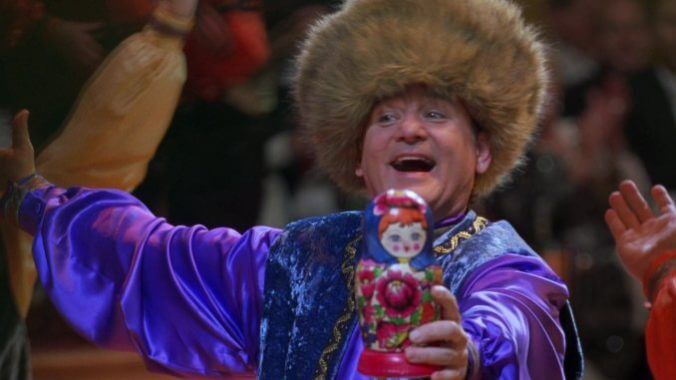25 Years Later, The Man Who Knew Too Little Is a Ridiculous Yet Entertaining Relic of Its Time

Both Alfred Hitchcock’s The Man Who Knew Too Much (the 1956 remake, specifically) and Jon Amiel’s The Man Who Knew Too Little feature memorable performances during their climaxes. In the former, Doris Day, playing a mother whose child has been kidnapped, loudly sings the Academy Award-winning song “Que Sera, Sera (Whatever Will Be, Will Be)” so her son can follow her voice to safety; Bill Murray joins in a traditional Russian dance in the latter, carelessly throwing around a bomb disguised as a matryoshka doll.
Besides an assassination plot and the London setting, that’s where the similarities between the two films end. The spy comedy, which hit theaters 25 years ago today, is actually based on Robert Farrar’s novel Watch That Man. Bill Murray plays Wallace Ritchie, a hapless American who decides to surprise-visit his brother James (Peter Gallagher) in London to celebrate his birthday. James is far too busy with his high-powered finance job, so he sends his brother off to participate in an interactive play called the Theatre of Life. However, Wallace unwittingly finds himself in the middle of a very real plot to reignite the Cold War. He acts far braver than he usually would as a mild-mannered Blockbuster clerk; his cluelessness about the danger surrounding him is probably his biggest asset. In the process, he meets an escort named Lori (Joanne Whalley), who’s knowingly embroiled in the political machinations and, of course, falls for Wallace.
The Man Who Knew Too Little was released at a strange time in Murray’s career. He was waning from his leading man days, where he’d play the devil-may-care Dr. Peter Venkman in Ghostbusters (1983) and the 1989 sequel, or the arrogant weatherman Phil Connors in Groundhog Day (1993). The movie came out just before Murray became Wes Anderson’s favorite regular, starting with Rushmore in 1998, or his world-weary turn in Lost in Translation. It was a transitional period, and Murray’s schtick doesn’t quite work in the role of Wallace, who’s supposed to be oblivious and a touch naive (despite this obviously skewing close to his titular part in What About Bob?). However, Murray comes across as too cynical and knowing, either never goofy enough for the bit or going broad in moments that don’t feel earned. Everyone else around him is playing it straight and committing, while his efforts feel half-hearted.
-

-

-

-

-

-

-

-

-

-

-

-

-

-

-

-

-

-

-

-

-

-

-

-

-

-

-

-

-

-

-

-

-

-

-

-

-

-

-

-








































